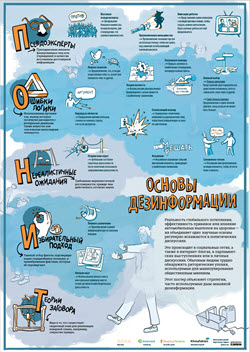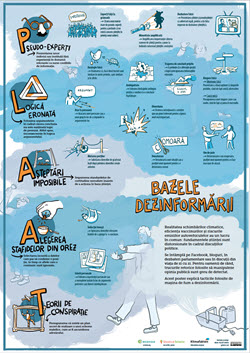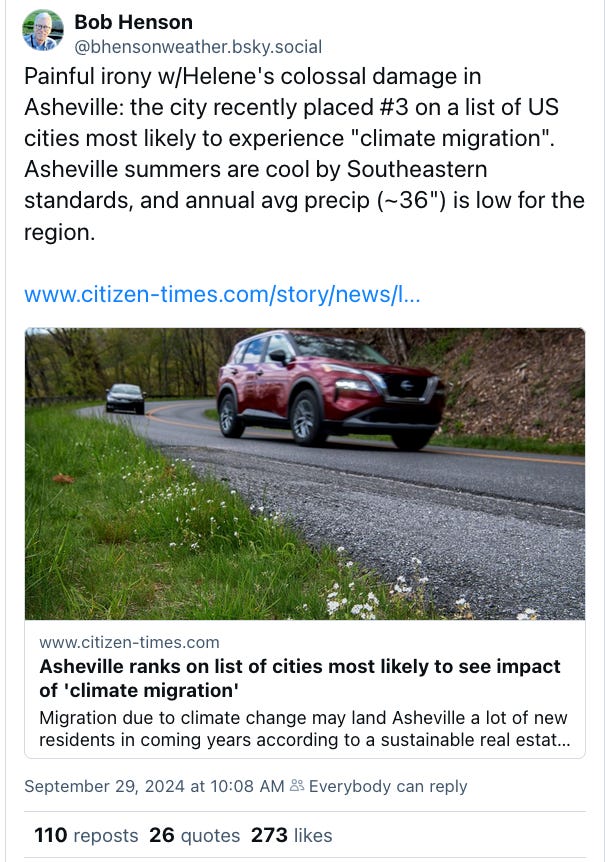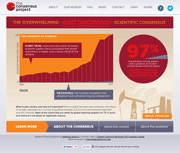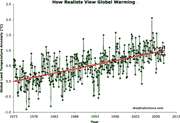Clean energy jobs grew more than twice the rate of the overall economy in 2023 – and every state has its own piece of the story to tell.
By the end of 2023, there were over half a million jobs in wind, solar, and energy storage in the United States, according to the Department of Energy’s 2024 U.S. Energy and Employment Jobs Report. Jobs within these sectors include design, manufacturing, trade, construction, and operation of energy systems.
Just two states hold one-third of the jobs in clean electricity generation: California and Texas. The rest of the jobs were distributed across the rest of the country in unequal and sometimes unexpected ways.
Get a high-level look at the latest clean energy jobs data in our interactive map below. Each state is ranked by the total number of jobs in solar, wind, and energy storage. Hover over or tap on any state to see the data broken down by sector as well as per capita.
Read on for key takeaways from the new data, including state standouts and lackluster performances.
2024 SkS Weekly Climate Change & Global Warming News Roundup #43
Posted on 27 October 2024 by BaerbelW, Doug Bostrom, John Hartz
Story of the week
 As an experiment, we asked Google's Gemini for help categorizing the articles we shared during the week. The result is the bullet list below and we'd like to know how useful that kind of generated summary is for you, so please let us know in the comments!
As an experiment, we asked Google's Gemini for help categorizing the articles we shared during the week. The result is the bullet list below and we'd like to know how useful that kind of generated summary is for you, so please let us know in the comments!
Here are the main topics extracted from the articles, along with their publishing outlets:
Climate Change and its Impacts:
- Global warming and its effects on weather patterns, ecosystems, and human health (The Guardian, New York Times, Vox, Yale Climate Connections, MIT News, The Independent (UK), CNN)
- Extreme weather events, such as hurricanes, floods, droughts, and wildfires (The Guardian, New York Times, Vox, Yale Climate Connections, MIT News, The Independent (UK), CNN)
- Ocean acidification and marine ecosystem degradation (The Guardian, CNN)
- Impact on human activities, including agriculture, tourism, and infrastructure (The Guardian, MIT News)
Climate Policy and Politics:
- Climate change denial and misinformation (The Guardian, USA Today, Skeptical Science)
- International climate agreements and negotiations (Inside Climate News, The Guardian)
- Climate policies and regulations in different countries (Washington Post, Inside Climate News, Grist)
- The role of political leaders and public opinion in addressing climate change (The Guardian, Grist)
Climate Solutions and Adaptation:
- Renewable energy and clean technologies (Inside Climate News)
- Carbon capture and storage (Inside Climate News)
- Climate adaptation strategies (Yale Climate Connections)
- Public awareness and education (Yale Climate Connections, The Guardian)
- Individual actions to reduce carbon footprint (The Guardian)
Scientific Research and Reporting:
- Latest climate science findings and research (The Guardian, New York Times, Vox, Yale Climate Connections, MIT News, The Independent (UK), CNN, Skeptical Science)
- Climate modeling and projections (The Guardian, MIT News)
- Data analysis and visualization (Skeptical Science)
- Media coverage of climate change (The Guardian, USA Today, Vox, Yale Climate Connections, MIT News, The Independent (UK), CNN)
Stories we promoted this week, by publication date:
Before October 20
- Trump has vowed to gut climate rules. Oil lobbyists have a plan ready., Business, Washington Post, Evan Halper & Josh Dawsey. "As companies fall short on methane emission reductions, a top trade group has crafted a road map for dismantling key Biden administration rules."
- What happens to the world if forests stop absorbing carbon? Ask Finland, The Age of Extinction, Environment, The Guardian, Patrick Greenfield. "Natural sinks of forests and peat were key to Finland’s ambitious target to be carbon neutral by 2035. But now, the land has started emitting more greenhouse gases than it stores"
- Election Throws Uncertainty Onto Biden’s Signature Climate Law, Clean Energy, Inside Climate News, Nicholas Kusnetz. "The Inflation Reduction Act was enacted in a hyper-partisan environment, but it has gained support among Republicans. Will its emissions-cutting programs endure?"
- Kamala Harris urged to flesh out climate plan amid warnings about Trump, US News, The Guardian, Dharna Noor & Oliver Milman. "Democratic presidential nominee has raised alarm about Trump’s plans but has not said much about her own"
- Overwhelming majority of young Americans worry about climate crisis, Environment, The Guardian, Jessica Glenza. "Survey of young people aged 16-25 from all US states shows concerns across political spectrum"
- Trump's campaign leans on climate change denial: Six misleading claims debunked, USA Today, Kate S. Petersen.
- An Alarming Glimpse Into a Future of Historic Droughts, World, New York Times, Julie Turkewitz, Ana Ionova & José María León Cabrera. "Record dry conditions in South America have led to wildfires, power cuts and water rationing. The world’s largest river system, the Amazon, which sustains some 30 million people across eight countries, is drying up."
- Is climate change really making hurricanes worse?, Climate, Vox, Umair Irfan. "What we know — and don’t know — about how global warming influences tropical storms."
- Atmospheric Scientist Tackles Climate Change Misinformation On LinkedIn, ATM News, Grant Hawkins. Dr. Gunnar Schade and students in his class collaborated with misinformation researchers at Ripple Research for a deep dive into climate change misinformation circulating on LinkedIn, a realm where the extent and impact of misinformation, which is surprisingly thriving, is largely unexplored.
Fact brief - Do volcanoes emit more CO2 than humans?
Posted on 26 October 2024 by Guest Author
![]() Skeptical Science is partnering with Gigafact to produce fact briefs — bite-sized fact checks of trending claims. This fact brief was written by Sue Bin Park from the Gigafact team in collaboration with members from our team. You can submit claims you think need checking via the tipline.
Skeptical Science is partnering with Gigafact to produce fact briefs — bite-sized fact checks of trending claims. This fact brief was written by Sue Bin Park from the Gigafact team in collaboration with members from our team. You can submit claims you think need checking via the tipline.
Do volcanoes emit more CO2 than humans?
 Volcanoes release CO2, but the amount is minimal compared to human-caused emissions.
Volcanoes release CO2, but the amount is minimal compared to human-caused emissions.
According to the U.S. Geological Survey, volcanoes emit around 180-440 million tons of CO2 annually. In contrast, human activities, primarily burning fossil fuels, emitted 41.5 billion tons of CO2 in 2022—over 100 times more.
Volcanoes are part of the Earth’s slow carbon cycle, where carbon is gradually recycled between the Earth’s mantle and atmosphere over millions of years. Volcanic CO2 is eventually reabsorbed by the weathering of rocks and ocean absorption, keeping the carbon cycle in balance over long timeframes.
Human activity, however, is releasing carbon at a rate far beyond what the natural carbon cycle can handle, overwhelming the Earth’s ability to balance CO2 levels. While volcanic CO2 emissions have been stable for millions of years, human-caused emissions have rapidly accelerated since the Industrial Revolution, making human activity the dominant driver of rising atmospheric CO2.
Go to full rebuttal on Skeptical Science or to the fact brief on Gigafact
This fact brief is responsive to conversations such as this one.
Sources
USGS Volcanic gases can be harmful to health, vegetation and infrastructure
Our World in Data CO2 emissions
NASA The Carbon Cycle
USGS Volcano Watch — Which produces more CO2, volcanic or human activity?
Skeptical Science New Research for Week #43 2024
Posted on 24 October 2024 by Doug Bostrom, Marc Kodack
Open access notables
The rate of global sea level rise doubled during the past three decades, Hamlington et al., Communications Earth & Environment:
The rise in globally averaged sea level—or global mean sea level—is one of the most unambiguous indicators of climate change. Over the past three decades, satellites have provided continuous, accurate measurements of sea level on near-global scales. Here, we show that since satellites began observing sea surface heights in 1993 until the end of 2023, global mean sea level has risen by 111 mm. In addition, the rate of global mean sea level rise over those three decades has increased from ~2.1 mm/year in 1993 to ~4.5 mm/year in 2023. If this trajectory of sea level rise continues over the next three decades, sea levels will increase by an additional 169 mm globally, comparable to mid-range sea level projections from the IPCC AR6.
Climate emotions, thoughts, and plans among US adolescents and young adults: a cross-sectional descriptive survey and analysis by political party identification and self-reported exposure to severe weather events, Lewandowski et al., The Lancet Planetary Health:
We evaluated survey responses from 15 793 individuals (weighted proportions: 80·5% aged 18–25 years and 19·5% aged 16–17 years; 48·8% female and 51·2% male). Overall, 85·0% of respondents endorsed being at least moderately worried, and 57·9% very or extremely worried, about climate change and its impacts on people and the planet. 42·8% indicated an impact of climate change on self-reported mental health, and 38·3% indicated that their feelings about climate change negatively affect their daily life. Respondents reported negative thoughts about the future due to climate change and actions planned in response, including being likely to vote for political candidates who support aggressive climate policy (72·8%). In regression models, self-reported exposure to more types of severe weather events was significantly associated with stronger endorsement of climate-related distress and desire and plans for action. Political party identification as Democrat or as Independent or Other (vs Republican) was also significantly associated with stronger endorsement of distress and desire and plans for action, although a majority of self-identified Republicans reported at least moderate distress.
Coordinating the energy transition: Electrifying transportation in California and Germany, Goedeking & Meckling, Energy Policy:
California and Germany share ambitious emission reduction targets. Yet California is ahead of Germany in electrifying transportation by several metrics, including the number of public charging stations. We show that variation in the politics of coordination in California and Germany explains the different outcomes. Transforming energy systems requires coordination across various complementary technologies and infrastructures—here between the supply of electric vehicles and the buildout of charging stations. In California, a strong electrification coalition emerged across automakers selling electric vehicles as well as utilities and third-party firms providing charging infrastructure. Power market rules made capital investments for charging infrastructure instantly profitable for California monopoly utilities. By contrast, in Germany's liberalized power market, investing in capital-intensive charging infrastructure was not profitable for electric utilities. As a result, utilities did not emerge as a political force in the electrification coalition. Instead, utilities and automakers were in gridlock, failing to coordinate electric vehicle rollout and public charging station buildout. Our findings highlight the limits of business-led coordination, raising the question which institutions help address coordination failures in clean energy transitions.
Over-reliance on land for carbon dioxide removal in net-zero climate pledges, Dooley et al., Nature Communications:
Achieving net-zero climate targets requires some level of carbon dioxide removal. Current assessments focus on tonnes of CO2 removed, without specifying what form these removals will take. Here, we show that countries’ climate pledges require approximately 1 (0.9–1.1) billion ha of land for removals. For over 40% of this area, the pledges envisage the conversion of existing land uses to forests, while the remaining area restores existing ecosystems and land uses. We analyse how this demand for land is distributed geographically and over time. The results are concerning, both in terms of the aggregate area of land, but also the rate and extent of land use change. Our findings demonstrate a gap between governments’ expected reliance on land and the role that land can realistically play in climate mitigation. This adds another layer to the observed shortcomings of national climate pledges and indicates a need for more transparency around the role of land in national climate mitigation plans.
Wildfire Emissions Offset More Permafrost Ecosystem Carbon Sink in the 21st Century, Zhu et al., Earth's Future:
Permafrost ecosystems in high-latitudes stock a large amount of carbon and are vulnerable to wildfires under climate warming. However, major knowledge gap remains in the effects of direct carbon loss from increasing wildfire biomass burning on permafrost ecosystem carbon sink. In this study, we used observation-derived data sets and Coupled Model Intercomparison Project Phase 6 (CMIP6) simulations to investigate how carbon emissions from wildfire biomass burning offset permafrost ecosystem carbon sink under climate warming in the 21st century. We show that the fraction of permafrost ecosystem carbon sink offset by wildfire emissions was 14%–25% during the past two decades. The fraction is projected to be 28%–45% at the end of this century under different warming scenarios. The weakening carbon sink is caused by greater increase in wildfire emissions than net ecosystem production in permafrost regions under climate warming. The increased fraction of ecosystem carbon sink offset by wildfire carbon loss is especially pronounced in continuous permafrost region during the past two decades.
Feedbacks From Young Permafrost Carbon Remobilization to the Deglacial Methane Rise, Sabino et al., Global Biogeochemical Cycles:
Here, we investigate the large-scale permafrost remobilization at the Younger Dryas-Preboreal transition (ca. 11.6 ka BP) using the sedimentary record deposited at the Lena River paleo-outlet (Arctic Ocean) to reflect permafrost destabilization in this vast drainage basin. Terrestrial OC was isolated from sediments and characterized geochemically measuring δ13C, Δ14C, and lignin phenol molecular fossils. Results indicate massive remobilization of relatively young (about 2,600 years) permafrost OC from inland Siberia after abrupt warming triggered severe active layer deepening. Methane emissions from this young fraction of permafrost OC contributed to the deglacial CH4 rise. This study stresses that underestimating permafrost complexities may affect our comprehension of the deglacial permafrost OC-climate feedback and helps understand how modern permafrost systems may react to rapid warming events, including enhanced CH4 emissions that would amplify anthropogenic climate change.
From this week's government/NGO section:
Ukraine’s Energy and Climate Challenges, Special Editors, Susanne Nies and Olha Bondarenko, Ukraine Analytical Journal
This issue of the Ukraine Analytical Journal is devoted to Ukraine’s energy and climate challenges. How can the country deal with the paramount heat and power deficit expected for the coming winter? What solutions are at hand? And how can these short-term solutions be consistent with the needs of a more mid- and long-term clean energy transition?
Impact of Climate Change on Health and Drug Demand, Abir et al., RAND
The authors of this report estimated how the anticipated effects of climate change on the prevalence of a sample of four chronic conditions — cardiovascular disease (CVD), asthma, end-stage renal disease (ESRD), and Alzheimer's disease — will affect demand for the drugs needed to treat them (metoprolol, albuterol, heparin, and donepezil, respectively). To generate these estimates, the authors conducted an environmental scan of the peer-reviewed and gray literature and developed a medical condition–specific systems dynamics model. The model can help inform policies for ensuring drug supply under various climate scenarios.
Climate Change & Crime, Peter Schwartzstein, The Center for Climate and Security
Crime has received relatively little attention to date in the climate security literature. This brief paper is an attempt to begin redressing that shortfall. While crime, as a form of insecurity, might seem low stakes in comparison to terrorism and inter-state conflict, its sheer breadth ensures that many more people have likely suffered from it compared with more ‘macro’ forms of climate-related violence. From petty theft to not-so-petty assaults, climate change is leaving its mark on almost every category of crime.
122 articles in 57 journals by 816 contributing authors
Physical science of climate change, effects
A Dynamical Adjustment Approach to Estimating Forced and Internal Variability in the North Atlantic, Nedza & DelSole, Journal of Climate Open Access pdf 10.1175/jcli-d-23-0651.1
A Dynamical Interpretation of the Intensification of the Winter North Atlantic Jet Stream in Reanalysis, Hermoso et al., Journal of Climate Open Access pdf 10.1175/jcli-d-23-0757.1
Why widening highways doesn’t reduce traffic congestion
Posted on 23 October 2024 by Guest Author
This is a re-post from Yale Climate Connections by Sarah Wesseler
California prides itself on its climate leadership. And the state’s work on transportation – its largest source of emissions – is no exception; its electric vehicle policies have been adopted by other states across the country. Sacramento lawmakers have also taken ambitious steps to reduce car use altogether, developing regulations aimed at reshaping communities to encourage walking, biking, and taking public transportation.
But on-the-ground reality often doesn’t live up to this vision. In particular, communities throughout the state continue to invest heavily in highway expansion projects that undermine efforts to change how people get around. Because of a phenomenon known as induced travel, these projects lead Californians to spend more time, not less, behind the wheel.
Amy Lee, a postdoctoral scholar at the UCLA Institute of Transportation Studies, has spent years studying induced travel and the politics of highway expansions in California. Yale Climate Connections spoke with her to learn more.
This interview has been edited and condensed.
Yale Climate Connections: Can you give me a high-level overview of induced travel? How does it work?
Amy Lee: So the biggest factor that people consider when deciding how to get around is cost. That’s a matter of dollars, but also time – time is a really, really important factor in how we travel. When a particular roadway is congested, traveling on it can take a long time, or an unpredictable amount of time, which discourages people from using it.
Highway widening is kind of like putting travel on sale. It attempts to reduce congestion by expanding the amount of roadway supply, reducing the time cost of travel for travelers using it. So let’s say traffic kept me from going to a restaurant I really like that’s 20 miles away, but after the highway is widened, I can go there more frequently. Or I might choose a doctor in the next town over as opposed to the one in my neighborhood.
We rearrange our travel patterns because of highway expansions, and the new driving that results is what we call induced travel. And research has shown that because of induced travel, congestion returns to previous levels about five to 10 years after the highway is widened.
YCC: Is this something that’s been discovered recently, or have we known about it for a while?
Lee: We’ve measured this for a really long time. It’s been observed for at least 100 years, and it’s been measured with increasingly advanced statistical methods since the ’70s and ’80s.
YCC: So highway expansion clearly seems problematic from a transportation planning perspective. Can you say more about how it affects climate change?
Lee: There are several ways. One is that the materials involved in physically making highways and roadways – concrete, aggregate, asphalt – are incredibly carbon-intensive. Highway expansions emit a lot of carbon in their production.
Then, once highways have been built, we develop our communities around them, building further out along these highway corridors, which generates auto use, which leads to more emissions. Right now, automobiles run mostly on fossil fuels, and this seems like it will be the case for a long time.
Highway expansions can also make it more difficult to get around urban neighborhoods. I live in a city with the classic set of highways that were built right through downtown to bring suburban commuters into the metropolitan core, severing neighborhoods like mine from the city center. To get downtown from where I live, you have to cross under the highway two times. Researchers have been doing really cool work about how that impedes walking and biking. As roads are expanded, not only do your shopping mall or your doctor’s office go further down the highway, but it also becomes a lot harder to get around your own neighborhood without driving, even if you’re just going a short distance.
Climate Risk
Posted on 22 October 2024 by Ken Rice
This is a re-post from And Then There's Physics
I realise that I haven’t written anything for a while and am unlikely to become particularly prolific again anytime soon. However, there’s something I’ve been thinking about and thought that I would write a post. It relates to something Alex Trembath has written in an article about Climate Risk. Alex is the Deputy Director of the Breakthrough Institute or, as some call it, the Bad Take Institute.
Alex’s article is highlighting how people often get statistical relationships wrong, and he’s probably right. Properly interpreting statistics is difficult and it’s certainly not something I’d claim to never get wrong. The basic point he is making is that a small shift in a distribution can have a large effect on the extremes. For example, if we consider one side of a Guassian distribution, then events more extreme than 1σ, 2σ and 3σ happen 16%, 2%, and 0.1% of the time, respectively. If we then shift the distribution by 1σ, the same events will now happen 50%, 16%, and 2% of the time. Essentially, what was a 3σ event has now become about 20 times more likely.
The example Alex uses is people misunderstanding the wild swings in Nate Silver’s US election predictions. These don’t mean Silver’s model is horribly wrong. They’re happening because small shifts in the probability distribution can have a large effect on the expected outcome.
However, when it comes to extreme climate events, Alex seems to reverse the argument. For a particular event, climate change is assessed to have made that event 30 times more likely. However, the analysis also indicates that the same event would have been only a little bit less intense in a pre-industrial climate, which is what Alex seems to think is important. His point is that “[w]ith climate change, they instead tend to emphasize the statistical swings, and ignore the modesty of the shifts in the actual climate.”
I realise that how we interpret this information is somewhat subjective, so am not suggesting that Alex is wrong to highlight this. However, in my view there are some other factors to consider.
Welcome to the world of personal air conditioning
Posted on 21 October 2024 by Guest Author
This is a re-post from the Climate Brink by Andrew Dessler. This is part two of his series on air conditioning. Part one can be found here.
Let’s look at Houston’s summertime temperatures:
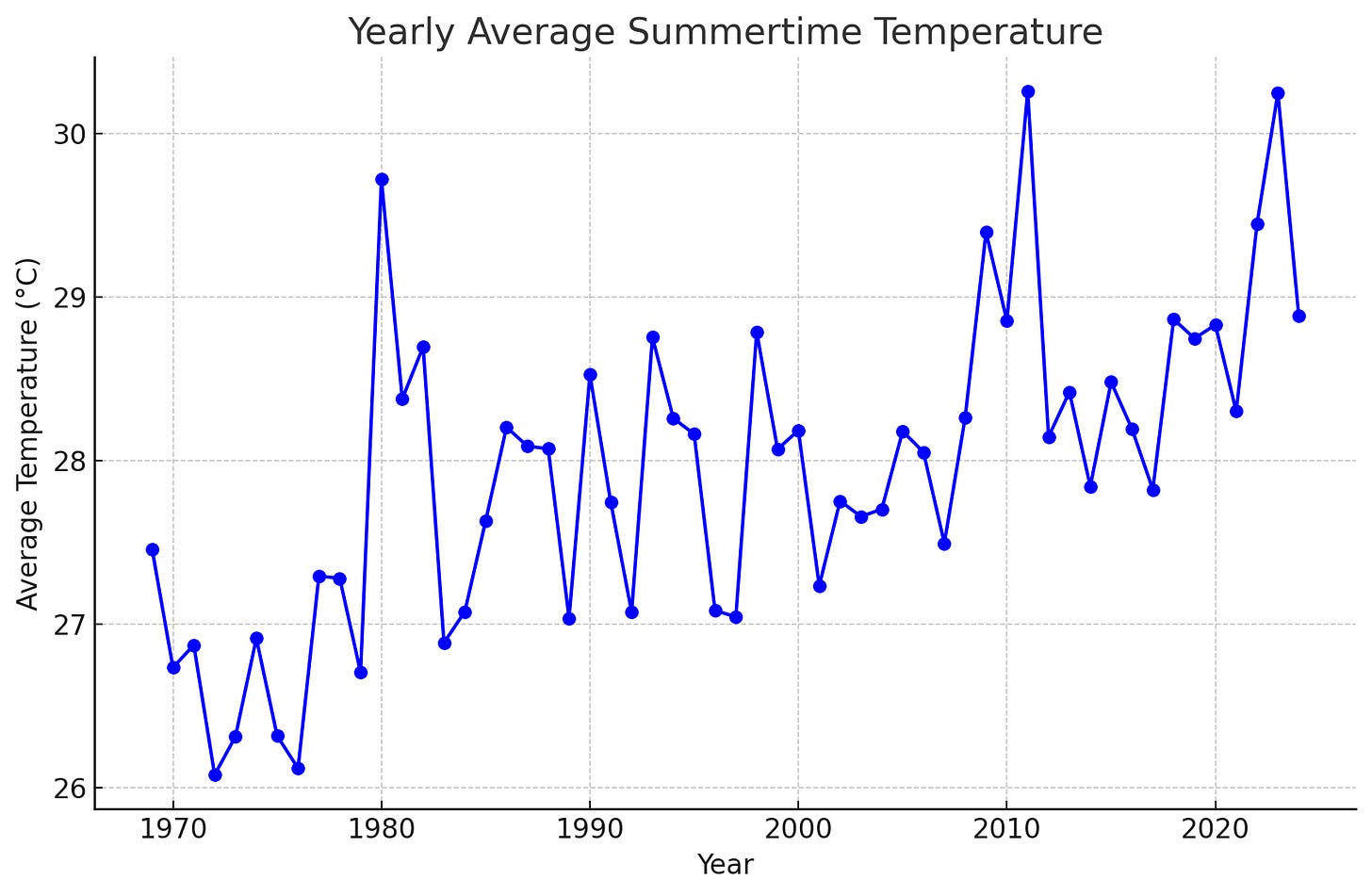
Wow, Houston has warmed a lot in the summer. In the 1970s, summers were about 3C (5F) cooler than they are today, enough to turn a 97F day into a 102F day, which is a huge difference.
I grew up in Houston in the 1970s and I can personally confirm that summertime Houston was always hot, but you were not a prisoner of air conditioning like you are now.
Given this warming, it was probably inevitable that personal cooling devices, designed to cool you and only you, would become more popular. Let’s go over some of this new technology.
For example, here are neck fans:
2024 SkS Weekly Climate Change & Global Warming News Roundup #42
Posted on 20 October 2024 by BaerbelW, Doug Bostrom, John Hartz
Story of the week
Here's another week of stories describing how our species has become a force of nature by creating a mighty industry now spewing unintended consequences, spanning from the upper atmosphere down to the rotational behavior of our entire planet Earth. In the middle: us and our fellow creatures, buffeted by violent weather, pestilence, starvation, dehydration and various other horrors, all made more dire by our big accident of changing our climate.
We've accidentally taken on god-like powers. But we're more like Greek gods; our efforts seemingly end in hubristic folly as much as they do acts of virtue. The Greeks wrote fables of gods as commentary on human nature and we remain obedient to this plot device— but at scale and type now uncomfortably close to the literal as opposed to metaphorical text of these ancient stories. Our human nature is now a seemingly inexorable force of nature; we don't seem to know how to control what we've become, what we've created.
If human nature rather than technological prowess is the root cause of our problem, it seems reasonable that better understanding of human nature rather than yet more engineering is key to threading our way out of our climate problem. This isn't a novel idea; social scientists have been working intensively on the psychological underpinnings of our climate problem for decades and we're beginning to get a solid grip on the common, basic fallibilities that lead us to commit and sustain titanic blunders such as randomly changing our planet's geophysics for the worse.
Perhaps more importantly, researchers are working specifically on why we'd continue to behave in ways that we know are causing ourselves harm. One such avenue leads to the concept of "energy transition justice," a term including workers in the fossil fuel industry.
Workers in the fossil fuel industry facing energy transition are a subject of intensive academic investigation, with a cursory check revealing over 13,000 publications for 2024 alone. Interest in this group includes not only matters of fairness and equity but also the possibility that as a matter of policy needing to be bracketed by operational politics, a large group of workers threatened with economic disenfranchisement can be a showstopper for for climate mitigation policy implementation. Again as a matter of human nature, people being governed by fear don't make good decisions, so understanding and discovering how to take away the cause for fright makes entirely good sense.
But it's rarely or never the case that people embedded in the fossil fuel industry are visited by researchers with a Margaret Mead level of commitment to sharing how these lives are lived, identifying connections of empathy to help provide us with the insight we need to ease fear and thus foster cooperation for the greater good.
To help us better understand people who have grown up in a multigenerational dependency on the economic feature called the fossil fuel industry and are quite naturally responding with fear, loathing and resistance to the end of their accustomed lifestyle— due to circumstances beyond their direct control— we could benefit from some embedded cultural anthropology. Thanks to Citizens Climate Lobby, we have news about what is essentially just such an effort, even if it's not flying the cultural anthropologist flag. Connecting about climate change with the most skeptical people in the USA is our Story of the Week, written by CCL intern author Kate Derbas and delving into Ben Stillerman's residence in Utah's coal-dependent Emery County. Stillerman lived in Emery County while filming interviews and conversations with people thoughtlessly included in the term "dirty energy."
Of course folks in Emery County are not dirty. They're not top industry executives engaged in concerted lying campaigns. But as a matter of human nature they're responding to being characterized in that way quite poorly. This in combination with what they see as an existential threat and what will certainly be a large upheaval in their lived experience combine to produce anger and fear, and neither of those emotions is conducive to cooperation or clear thinking.
Consider: if anybody has a good reason to believe the lies we're told about climate change by the fossil fuel industry, it's hands-on workers in the fossil fuel industry— with mortgages and hungry children— depending on sincere belief that one is living a good life, being good. This is a magnet for motivated reasoning, for naturally uncritical acceptance of comforting beliefs. They're victims, same as the rest of us.
It doesn't take an Einstein to understand that even if one doesn't give a toss about fairness, as a matter of pure pragmatism we need to treat these people well, treat them as we'd prefer for ourselves. Emery County is multiplied across the United States, and across the entire globe. This collective locus of hurt feelings and economic fright is already a drag on sorting out our climate problem. Left unaddressed, it will only become worse.
It's better— easier and more productive— to pay attention to fairness, to empathize. Stillerman's entire documentary series on Emery County titled True False Hot Cold is available on Youtube.
Stories we promoted this week, by publication date:
Before October 13
- Hurricanes Amplify Insurance Crisis in Riskiest Areas, Business, New York Times, Emily Fitter. "After Helene and Milton, some small Florida companies risk bankruptcy. Larger ones will be in the hot seat with lawmakers and consumer groups."
- Atmospheric rivers are shifting poleward, reshaping global weather patterns, Environment & Energy, The Conversation US, Zhe Li.
- Hurricane Milton's downpour around Tampa Bay was a 1-in-1,000-year rain event St. Petersburg had 18.31 inches of rain — or more than 1.5 feet — in 24 hours., Science, NBC News, Denise Chow. "St. Petersburg had 18.31 inches of rain — or more than 1.5 feet — in 24 hours."
- Climate Change Made Hurricane Milton Stronger, With Heavier Rain, Scientists Conclude, Inside Climate News, Sean Sublette. A rapid analysis of rainfall trends and Gulf of Mexico temperatures shows many similarities to Hurricane Helene less than two weeks earlier.
- Why Disasters Like Hurricanes Milton and Helene Unleash So Much Misinformation, Scientific American, Ben Guarino. "Falsehoods spread when uncertainties—and emotions—are high after hurricanes"
- Hurricanes do little to move Republicans on climate, Climatewire, E&E News, Emma Dumain. "Recent storms have devastated numerous conservative districts. That doesn’t mean their lawmakers will change course."
Skeptical Science New Research for Week #42 2024
Posted on 17 October 2024 by Doug Bostrom, Marc Kodack
Open access notables
The influence of partisan news on climate mitigation support: An investigation into the mediating role of perceived risk and efficacy, Choi & Hart, Risk Analysis:
Perceptions of efficacy play a central role in motivating people to engage in climate actions. However, there has been little investigation into how different climate efficacy beliefs are formed and how they may be associated with support for climate mitigation policies. This study, based on the motivated control framework, examines how risk perceptions may differentially be associated with four types of efficacy constructs (self-efficacy, personal outcome expectancy, collective efficacy, and collective outcome efficacy). It also places the motivated control framework in the context of the partisan information sphere and examines how exposure to partisan news may influence mitigation policy support through the mediators of risk perceptions and the efficacy constructs. Results suggest that liberal- and conservative-leaning news exposure, respectively, associate with higher and lower supports for policies. Overall, risk perception was a significant mediator, and the mediating function of efficacy varied depending on the specific construct being examined. For liberal news use, increased risk perceptions had a positive association with policy support through self-efficacy and collective outcome expectancy but also had an unexpected negative association with policy support through personal outcome expectancy and collective efficacy. For conservative news use, decreased risk perceptions resulted in further decreased beliefs of self-efficacy and collective outcome expectancy, resulting in lower levels of support for climate policies. We also find that political ideology is a significant moderator for the mediation model. Implications for climate change communication are discussed.
Gains in soil carbon storage under anthropogenic nitrogen deposition are rapidly lost following its cessation, Propson et al., Ecology:
In the Northern Hemisphere, anthropogenic nitrogen (N) deposition contributed to the enhancement of the global terrestrial carbon (C) sink, partially offsetting CO2 emissions. Across several long-term field experiments, this ecosystem-level response was determined to be driven, in part, by the suppression of microbial activity associated with the breakdown of soil organic matter. However, since the implementation of emission abatement policies in the 1970s, atmospheric N deposition has declined globally, and the consequences of this decline are unknown. Here, we assessed the response of soil C storage and associated microbial activities, in a long-term field study that experimentally increased N deposition for 24 years. We measured soil C and N, microbial activity, and compared effect sizes of soil C in response to, and in recovery from, the N deposition treatment across the history of our experiment (1994–2022). Our results demonstrate that the accumulated C in the organic horizon has been lost and exhibits additional deficits 5 years post-termination of the N deposition treatment. These findings, in part, arise from mechanistic changes in microbial activity. Soil C in the mineral soil was less responsive thus far in recovery. If these organic horizon C dynamics are similar in other temperate forests, the Northern Hemisphere C sink will be reduced and climate warming will be enhanced.
Vulnerability of Arctic-Boreal methane emissions to climate change, Parmentier et al., Frontiers in Environmental Science:
In this review, we assess the various sources and sinks of methane from northern high latitudes, in particular those that may be enhanced by permafrost thaw. The largest terrestrial sources of the Arctic-Boreal region are its numerous wetlands, lakes, rivers and streams. However, fires, geological seeps and glacial margins can be locally strong emitters. In addition, dry upland soils are an important sink of atmospheric methane. We estimate that the net emission of all these landforms and point sources may be as much as 48.7 [13.3–86.9] Tg CH4 yr−1. The Arctic Ocean is also a net source of methane to the atmosphere, in particular its shallow shelves, but we assess that the marine environment emits a fraction of what is released from the terrestrial domain: 4.9 [0.4–19.4] Tg CH4 yr−1. While it appears unlikely that emissions from the ocean surface to the atmosphere are increasing, now or in the foreseeable future, evidence points towards a modest increase from terrestrial sources over the past decades, in particular wetlands and possibly lakes. The influence of permafrost thaw on future methane emissions may be strongest through associated changes in the hydrology of the landscape rather than the availability of previously frozen carbon. Although high latitude methane sources are not yet acting as a strong climate feedback, they might play an increasingly important role in the net greenhouse gas balance of the Arctic-Boreal region with continued climate change.
Weaponization of climate and environment crises: Risks, realities, and consequences, Vuong et al., Environmental Science & Policy:
The importance of addressing the existential threat to humanity, climate change, has grown remarkedly in recent years while conflicting views and interests in societies exist. Therefore, climate change agendas have been weaponized to varying degrees, ranging from the international level between countries to the domestic level among political parties. In such contexts, climate change agendas are predominantly driven by political or economic ambitions, sometimes unconnected to concerns for environmental sustainability. Consequently, it can result in an environment that fosters antagonism and disputes over power and position and increases the risk of prolonged confrontations, hindering the collective global efforts to mitigate and adapt to climate change. Through the current discourse, we aim to provide a preliminary definition of the weaponization of climate change and environmental sustainability and examine its risks and consequences on international relations, political dynamics, public perception, and the comprehensive integrity of climate action. We also recommend embracing a globally coordinated, scientifically substantiated approach to circumvent climate change by building an eco-surplus cultural value system.
From this week's government/NGO section
Florida Climate Survey - September 2024, Polsky et al., Florida Atlantic University
Most Floridians are more likely to support candidates who fight climate change: 52% agree with the statement: “A candidate's political record reducing the impacts of climate change would make me more likely to vote for that candidate.” There were differences based on the political parties of the respondents on the above question – 74% of Democrats agree with the statement, as compared to 35% of Republicans and 39% of respondents reporting no party affiliation. A large majority of Floridians support using more renewable energy in the state: 75% agree with the statement, “Florida should diversify its energy sources to include more electricity produced by renewable sources.” There was strong support across party lines with the above statement: 87% of Democrats agree, 68% of Republicans, and 66% of respondents reporting no party affiliation. Most Floridians are worried about the impact of climate change on insurance: 58% agree with the statement, “Climate change has me concerned about being able to afford and maintain my homeowner's insurance in Florida.”
Private Equity Climate Risks, Duong et al., Americans for Financial Reform Education Fund, Global Energy Monitor, and Private Equity Stakeholder Project
Private equity continues to transform the financial markets and the daily lives of communities around the globe. With over a trillion dollars in energy investments generating high greenhouse gas emissions and minimal public visibility, private equity firms play an outsized role in accelerating the climate crisis. New research for this edition of the scorecard reveals just how high the industry’s fossil fuel emissions are. The private equity energy portfolios covered in this report are responsible for an estimated, combined total of 1.17 gigatons of annual emissions. This figure equals 1.17 billion metric tons CO2 equivalent (CO2e) and is limited to the three categories covered in the scope of this research: upstream, liquefied natural gas (LNG) terminals, and coal plants, and does not represent the firms’ entire emissions footprint from energy investments. In the US alone, there were 28 weather and climate disasters in 2023, resulting in at least $92.9 billion in disaster damages, according to the National Centers for Environmental Information. The need for transparency, accountability, and a just transition to a clean energy economy has never been more urgent.
The security blind spot: Cascading climate impacts and tipping points threaten national security, Laybourn et al., Chatham House, the Royal Institute of International Affairs, The Global Systems Institute, the Institute for Public Policy Research, and The Strategic Climate Risks Initiative
The new UK government has initiated a Strategic Defence Review and is undertaking a review of national resilience. Security threats resulting from climate change should be at the core of the government’s approach. These threats have been consistently and significantly underestimated and now pose major security risks. Recent governments have not considered climate change a priority national security issue. Climate-security threats are non-linear and are escalating, posing profound challenges to national and international security.
104 articles in 50 journals by 610 contributing authors
Physical science of climate change, effects
Arctic climate response to European radiative forcing: a deep learning study on circulation pattern changes, Mehrdad et al., Weather and Climate Dynamics Open Access 10.5194/wcd-5-1223-2024
Gulf Stream mesoscale variabilities drive bottom marine heatwaves in Northwest Atlantic continental margin methane seeps, Wu & He, Communications Earth & Environment Open Access 10.1038/s43247-024-01742-8
Present-day methane shortwave absorption mutes surface warming relative to preindustrial conditions, Allen et al., Atmospheric Chemistry and Physics Open Access 10.5194/acp-24-11207-2024
Wanted: Better housing to help people stay cool on a hotter planet
Posted on 16 October 2024 by Guest Author
This is a re-post from Yale Climate Connections by Peter Graham and Mili Majumdar
 Apartments on the outskirts of New Delhi, India. (Photo credit: Adam Cohn / CC BY-NC 2.0)
Apartments on the outskirts of New Delhi, India. (Photo credit: Adam Cohn / CC BY-NC 2.0)
It was 117 degrees Fahrenheit (47°C) in Tunisia in July, yet our colleague Manel Ben Khelifa could not turn on the air conditioning “because the electricity grid has been shut down,” she explained.
“The power company is trying to conserve energy during peak periods by doubling electricity prices to discourage people from using air conditioning, but it’s not working,” Ben Khelifa told us during a heat wave in July 2024.
“It’s so hot, people would rather turn off anything but the air conditioning,” she said. “So then the power company turns off the power. It’s OK for young people like me but for my babies and my father, who has health issues, it’s inhumane. It wasn’t like this when I was a girl. It’s getting hotter.”
Extreme heat has gotten worse in many places as the Earth has warmed due to our reliance on fossil fuels. And we can’t just air-condition our way out of the problem, as about 7% of global emissions of heat-trapping pollution come from burning fossil fuels to generate heat and cooling inside buildings. This percentage will only grow without a serious course correction, especially in the developing world, which is rapidly urbanizing.
Life in the Appalachians once felt ‘untouchable.’ Then Helene struck.
Posted on 15 October 2024 by Guest Author
This is a re-post from Yale Climate Connections by Tree Meinch
 A person bicycles through floodwaters remaining from Hurricane Helene on October 4, 2024, in Swannanoa, North Carolina. Hundreds of people were killed in six states in the wake of the powerful hurricane, which made landfall as a Category 4. (Photo by Mario Tama/Getty Images)
A person bicycles through floodwaters remaining from Hurricane Helene on October 4, 2024, in Swannanoa, North Carolina. Hundreds of people were killed in six states in the wake of the powerful hurricane, which made landfall as a Category 4. (Photo by Mario Tama/Getty Images)
You could say James Guill has been running from hurricanes for his whole life.
The New Orleans native was just two years old when Hurricane Katrina swallowed his city in 2005 and became the most costly hurricane in U.S. history, claiming 1,833 lives.
During and after the storm, Guill’s family evacuated and sheltered in Virginia for two months. Then they returned, salvaged their house, and spent nearly two more decades – enduring other life-threatening storms and evacuations – at sea level.
Guill’s mother, Terenia Urban Guill, calls her son a Katrina baby, in the same way young parents today call their 2020 kids COVID babies: the world-altering moment shaped and informed them in fundamental ways.
“I don’t have direct memories,” James Guill said of Katrina. “But I say it’s in my bones.”
His history with torrential rains, flooding, and roof-shearing winds influenced his trajectory straight out of high school. He enrolled at the University of North Carolina at Asheville, where he’s studying environmental science.
“Being high up in the mountains felt a little bit untouchable,” Guill said. “It felt like one of the more secure areas.”
In recent years, many people have uprooted their lives to relocate to these mountains, driven by the growing risks of extreme weather events elsewhere. Asheville, North Carolina, has ranked high on lists of cities that some thought would be relatively shielded from climate change.
Hurricane Helene upended that understanding.
At least 230 people died across six states, nearly half of those in North Carolina, during the storm’s September 2024 rampage. Two weeks after Helene, many communities in the region remained without water or power. The devastation blindsided many residents, shaking their sense of climate security.
It’s a feeling that I know intimately. I grew up in western North Carolina before moving out of state to start my career.
Today, my hometown of Swannanoa looks like a wasteland. Semitrailers split open, spilling their innards across the muddy street above the Swannanoa River. Entire homes were swept from their foundations and ripped to pieces. Cars are still bent around mangled hardwoods.
Why have hurricanes gone crazy?
Posted on 14 October 2024 by Guest Author
This is a re-post from the Climate Brink by Kevin Trenberth
Have there been other years where multiple hurricanes hit Florida? That is one of the questions I am now getting. The answer is yes: in 2004, for instance.
The summer of 2004 was when four hurricanes made landfall in Florida, and the question was whether there was a human global warming role in the activity and thus the damage. To me it was obvious that there was.
I had worked extensively on climate change, and had connected the increases in sea surface temperatures, which were clearly and demonstrably linked to global warming, to increases in water vapor in the atmosphere.
This link is strong and physically based: over the oceans, where there is ample water at the surface, the water vapor goes up at 7% per 1C warming, the same rate as the atmosphere’s ability to hold water vapor. Accordingly, all storms reach out and gather in the available water vapor, which fuels the storm, and it rains harder. I reasoned that this should also apply to hurricanes.
None of this was reflected in any official 2004 NOAA statements on hurricanes and instead the extra activity was all attributed to natural variability. I agreed to participate in a news conference on the topic, set up by Harvard University, in which I cautiously suggested that yes, global warming was undoubtedly playing some role.
This led to a major outcry from the hurricane meteorologists, who were amazingly ill-informed about climate change matters. I did not answer the criticism directly, and instead published my views in a perspective in Science magazine in June 2005.
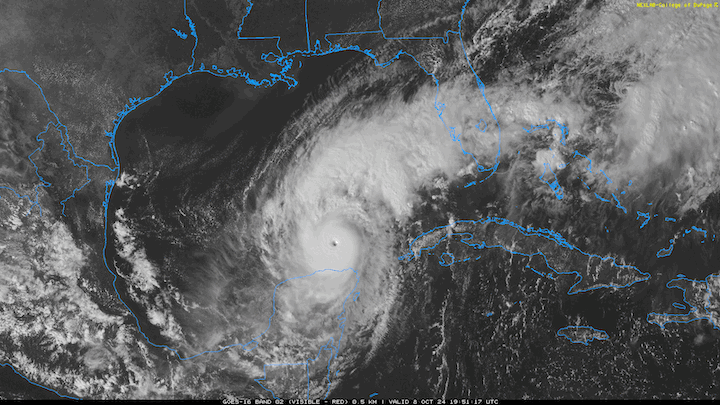
2024 SkS Weekly Climate Change & Global Warming News Roundup #41
Posted on 13 October 2024 by BaerbelW, Doug Bostrom, John Hartz
Story of the week
 For the third week in a row our Story of the Week involves hurricanes, most recently Hurricane Milton which led a brief life distinguished by explosive intensification, placing it as the Gulf of Mexico's most energetic late-season storm on record. The word cloud here captures the flavor of the past week's journalistic preoccupation with this storm as a feature related to and at least partially dependent on human-caused climate change.
For the third week in a row our Story of the Week involves hurricanes, most recently Hurricane Milton which led a brief life distinguished by explosive intensification, placing it as the Gulf of Mexico's most energetic late-season storm on record. The word cloud here captures the flavor of the past week's journalistic preoccupation with this storm as a feature related to and at least partially dependent on human-caused climate change.
Thanks to our increasing the efficiency of Earth's insulating blanket of greenhouse gases, we're having an affect on all features of the weather we experience. Unless we're to be mystified, surprised and needlessly harmed by bad weather we've added to our annual odds, it's important that we be able to distinguish our effects on the geophysics we experience as rain, wind, and the other features of our restless atmosphere that we call "weather." Fortunately there's an outfit doing exactly that, an initiative called World Weather Attribution (WWA). While the center of mass of WWA is academic in nature, the organization flips the usual sequence of publication; WWA analyses frequently feature as peer-reviewed publications in major academic journals, but their initial reporting is released as rapidly as possible, for the beneifit of ephemeral public attention.
Too late to make it into our collection of articles this week, WWA provided a detailed briefing on how Hurricane Milton was "upgraded" by our accidental tampering with our climate. In brief and as synopsized by Yale Climate Connections, here's what we know about Milton's juicing:
World Weather Attribution’s analysis found that storms with Milton’s wind speeds have become approximately 40% more frequent and the winds associated with storms of similar rarity have become nearly 11 mph (5 m/s) higher (an increase of about 10%) because of the 1.3 degrees Celsius (2.3°F) of global warming since preindustrial times. Thus, without climate change, Milton would have hit Florida as a Cat 2 with 110 mph winds instead of a Cat 3 with 120 mph winds.
Bold ours. No analogy is perfect, but we all know that if we turn up the burner beneath a pot of soup the soup will seethe more vigorously. Similarly and unsurprisingly, as we turn up the temperature of the Earth we inhabit it follows that certain features of our atmosphere will tend to behave more kinetically, including hurricanes. We've followed hurricanes Helene and Milton and both followed this simple logic. In Helene's case we saw ample evidence not only of surprising intensification but also the effects of the Clausius-Clapeyron relationship, whereby slightly warmer air can carry and later dump disproportionately larger amounts of moisture.
The larger story of Milton is that of violent weather inhabiting expanded brackets we ourselves have set. Is there a conclusion to this narrative? Perhaps it's that we should try to narrow the span of those brackets back to "normal" variations.
Stories we promoted this week, by publication date:
Before October 6
- Greening of Antarctica Is Another Sign of Significant Climate Shift on the Frozen Continent, Science, Inside Climate News, Bob Berwyn. "New research documents accelerating plant growth on the Antarctic Peninsula and nearby islands."
- Why Hurricane Helene Could Finally Change the Conversation Around Climate Change The massive personal and economic toll of unexpected inland, Science, Inside Climate News, Interview by Steve Curwood, Living on Earth. "The massive personal and economic toll of unexpected inland flooding may represent a turning point."
- The UK coal-fired power station that became a giant battery, Future, BBC News, Michael Marshall. "With the closure of the last coal-fired power station in the UK, it raises questions about how old fossil fuel infrastructure can be repurposed. One option is to use them to store energy from renewables."
- Hurricane Helene Prompts Questions About Raising Animals in Increasingly Vulnerable Places, Science, Inside Climate News, Georgina Gustin. "Greenhouse gas emissions from livestock are growing. So are climate-fueled storms that pummel the industry."
- Will carbon capture help the UK tackle climate change?, Climate & Science, BBC News, Mark Poynting & Justin Rowlatt.
- Hurricane Helene is a humanitarian crisis – and a climate disaster, Comment os Free, The Guardian,, Opinion by Rebecca Solnit. "Behind the violence of extreme weather is that of the fossil fuel industry, and Americans are suffering for it"
- A warmer, sicker world': Mosquitoes carrying deadly diseases are on an unstoppable march across the US, BBC Future, David Cox. "malaria and dengue are gaining new ground in the US. The mosquitoes that carry these diseases are thriving in a warming world."
Fact brief - Is more CO2 a good thing because it’s plant food?
Posted on 12 October 2024 by Guest Author
![]() Skeptical Science is partnering with Gigafact to produce fact briefs — bite-sized fact checks of trending claims. This fact brief was written by Sue Bin Park from the Gigafact team in collaboration with members from our team. You can submit claims you think need checking via the tipline.
Skeptical Science is partnering with Gigafact to produce fact briefs — bite-sized fact checks of trending claims. This fact brief was written by Sue Bin Park from the Gigafact team in collaboration with members from our team. You can submit claims you think need checking via the tipline.
Is more CO2 a good thing because it’s plant food?
 While CO2 is necessary for plant growth, the negative impacts of climate change, driven by man-made CO2 emissions, far outweigh short-term productivity gains.
While CO2 is necessary for plant growth, the negative impacts of climate change, driven by man-made CO2 emissions, far outweigh short-term productivity gains.
Plants need a balance of CO2, sunlight, water, and nutrients. Though more CO2 can initially boost growth, rising temperatures, disease vulnerability, shifting land fertility, and increased water demands offset these benefits.
The UN warns that global crop yields could decline by up to 30% by 2050, while a 2017 meta-analysis linked each degree of warming to a 3-7% yield loss for key crops like corn and soybeans. Losses are also attributed to increased disease pressure from altered climates.
Raised CO2 levels can also lower food quality. Reviews found reduced levels of essential nutrients in staple crops, while protein concentrations in grains like wheat and rice dropped by 10-15%.
The rapid human-induced accumulation of CO2 is producing more negative than positive consequences—for plants and the Earth at large.
Go to full rebuttal on Skeptical Science or to the fact brief on Gigafact
This fact brief is responsive to conversations such as this one.
Sources
Columbia Climate School How Climate Change Will Affect Plants
Scientific American Ask the Experts: Does Rising CO2 Benefit Plants?
Global Commission on Adaptation ADAPT NOW: A GLOBAL CALL FOR LEADERSHIP ON CLIMATE RESILIENCE
National Academy of Sciences Temperature increase reduces global yields of major crops in four independent estimates
Nature Climate change impacts on plant pathogens, food security and paths forward
Global Change Biology Effects of elevated CO2 on the protein concentration of food crops: a meta-analysis
PONIT and PLAAT: The FLICC poster now also available in Russian and Romanian
Posted on 11 October 2024 by BaerbelW
It is one of the most successful products of our German-language partner website klimafakten.de: a large-format infographic about typical disinformation strategies, not just in terms of climate. The poster has previously been available in eight languages, and now two more have been added. The new translations were produced with partners from Moldova and Russia.
If you are a regular user of our website, the abbreviation "FLICC" will certainly ring a bell. But you may also have seen it in connection with Covid-19 or the Cranky Uncle game or elsewhere on the Internet. In any case, the five letters stand for the five most common tricks used by disinformation campaigns: fake experts, logical fallacies, impossible expectations, cherry picking and conspiracy theories. Four and a half years ago, in April 2020, the collaboration between our team and klimafakten.de resulted in the initial publication of the poster in German ("PLURV") and English ("FLICC"). in addition to the digital online version, it's also available in A2 format on paper.
Over the years we have translated the graphic into six other languages: Dutch and Portuguese, Spanish and French, Luxembourgish and Polish. Now two more languages have been added: Russian and Romanian. And as with the previous versions, we have once again learned something about the respective target language. "Fake experts" are called "Psevdoyeksperty" in Russian and "Pseudi-Experti" in Romanian. "Logical fallacies" are called "Oshibki logiki" in Russia and "Logica Ernonatá" in Romania.
Skeptical Science New Research for Week #41 2024
Posted on 10 October 2024 by Doug Bostrom, Marc Kodack
Open access notables
Manifold increase in the spatial extent of heatwaves in the terrestrial Arctic, Rantanen et al., Communications Earth & Environment:
It is widely acknowledged that the intensity, frequency and duration of heatwaves are increasing worldwide, including the Arctic. However, less attention has been paid to the land area affected by heatwaves. Here, using atmospheric reanalysis and global climate models, we show that the area covered by heatwaves is substantially expanding in the terrestrial Arctic. Compared to the mid-20th century, the total land area affected by severe heatwaves in the Arctic has doubled, the area of extreme heatwaves has tripled, and the area of very extreme heatwaves has quadrupled. Furthermore, climate model projections suggest that the extent of heatwaves will continue to increase in the 21st century, but with large regional differences in heatwave magnitudes due to summer intraseasonal temperature variability. Our findings underscore the growing vulnerability of the Arctic region to extreme heat, potentially leading to severe impacts on both ecosystems and societies.
Anomalous Arctic warming linked with severe winter weather in Northern Hemisphere continents, Cohen et al., Communications Earth & Environment:
We have extended a recently developed metric that ingests United States station data—the accumulated winter season severity index—to a global indicator based on temperature and snowfall from reanalysis output. The expanded index is analyzed to reveal relationships between Arctic air temperatures/pressures and the probability of severe winter weather across the Northern Hemisphere midlatitudes. Here we find a direct and quasilinear relationship between anomalously high Arctic temperatures/pressures and increased severe winter weather, especially in northeastern continental regions downstream of maximum regional Arctic warming. Positive temperature trends in the Arctic are associated with positive trends in severe winter weather across the continents in mid- to late-winter, coinciding with an increase in stratospheric polar vortex disruptions. During the era of rapid Arctic warming, variability has decreased over the Arctic Ocean and Europe, but has increased in Canada, the Northern US and northeast Asia, indicating more pronounced shifts in weather conditions.
Rightwing populist attitudes and public support for climate policies in Western Europe: Widening the scope using the European Social Survey, Kulin & Johansson Sevä, PLOS Climate:
In Western Europe, rightwing populist parties and their supporters frequently deny the realities of climate change and oppose climate policies. Meanwhile, public opinion research has tied ideological orientations associated with rightwing populism to climate change denial/skepticism and climate policy opposition. Yet, comprehensive studies assessing the relative importance of various rightwing populist orientations across national contexts are lacking. Using European Social Survey data (Round 8) from 15 Western European countries, we systematically investigate the relationships between a large set of orientations related to rightwing populism and public views about climate change. The results show that nationalism and nativism, that is, orientations associated with the thick ideology of rightwing populism, appear to be comparably strong and consistent predictors, especially regarding opposition to climate change mitigation policies. However, the relative importance of different orientations varies across Western European countries, and depend on whether the focus is on policy attitudes or climate change beliefs.
A multi-model assessment of inequality and climate change, Emmerling et al., Nature Climate Change:
Climate change and inequality are critical and interrelated issues. Despite growing empirical evidence on the distributional implications of climate policies and climate risks, mainstream model-based assessments are often silent on the interplay between climate change and economic inequality. Here we fill this gap through an ensemble of eight large-scale integrated assessment models that belong to different economic paradigms and feature income heterogeneity. We quantify the distributional implications of climate impacts and of the varying compensation schemes of climate policies compatible with the goals of the Paris Agreement. By 2100, climate impacts will increase inequality by 1.4 points of the Gini index on average. Maintaining global mean temperature below 1.5 °C reduces long-term inequality increase by two-thirds but increases it slightly in the short term. However, equal per-capita redistribution can offset the short-term effect, lowering the Gini index by almost two points. We quantify model uncertainty and find robust evidence that well-designed policies can help stabilize climate and promote economic inclusion.
The energy commons: A systematic review, paradoxes, and ways forward, Bauwens et al., Energy Research & Social Science:
The growing literature on energy commons suggests that reimagining energy as a common resource is critical for transitioning away from fossil fuel-based systems. However, conceptual and empirical fragmentation in this literature limits our understanding of energy commoning practices. Through a systematic review of 85 articles, we aim to unify the field by analyzing it across three dimensions: material, institutional, and cultural. Materially, we find a focus on energy production, distribution, and use, with less attention to renewable resource harvesting, upstream (e.g., mining), and downstream (e.g., waste management) operations. Institutionally, the emphasis is on local, community-driven initiatives and participatory governance, with limited exploration of multi-scale approaches and other institutional logics. Culturally, the research is centered on Western contexts, highlighting a need for broader geographic and theoretical perspectives. From our analysis, we identify five paradoxes in the literature: 1) inclusivity and exclusivity, 2) a Western focus and the pluriverse, 3) decentralization alongside the need for coordinated governance, 4) a focus on generation and distribution as well as a whole value chain approach, and 5) viewing commons as an alternative to capitalism while acknowledging their co-optation by capitalist systems
Context matters when evacuating large cities: Shifting the focus from individual characteristics to location and social vulnerability, Rufat et al., Environmental Science & Policy:
Recent studies have found inconclusive results on the determinants of evacuation-related decisions and have reported widely varying evacuation rates, especially in high-density areas. We use a large dataset of geotagged evacuation choices in Paris, France (n?=?2976) during a flood, to show that while they are rarely addressed, location, social vulnerability, length of residence, and hazard exposure are critical predictors. They can be used to infer the impact of previous experience on evacuation intentions, which is usually difficult to collect at scales relevant to decision-making. We address multiple evacuation choices over time that have previously been overlooked, including gradually self-fueling spontaneous evacuations after observations of peers evacuating or flooding proximity and post-impact evacuation due to infrastructure disruption. Our findings reveal that many people wait until their home is flooded to evacuate. The gap between the initial share of people leaving immediately and the minority refusing to leave in any case even after their housing is flooded gradually fills when considering different evacuation behaviors over time. Such chronology might explain the wide range of evacuation rates reported in the literature. However, people in vulnerable situations and with increased hazard exposure are more likely to declare that they would disregard evacuation instructions. One key implication is that policies aimed at reducing social vulnerability might be more effective than communication campaigns to increase preparedness and support evacuation.
From this week's government/NGO section:
Pan-Arctic Methane: Current Monitoring Capabilities, Approaches for Improvement, and Implications for Global Mitigation Targets, Ackermann et al., Woodrow Wilson International Center for Scholars/ Polar Institute
Arctic carbon emissions from thawing permafrost will accelerate the pace of global climate disruption and reduce the remaining headroom for direct human emissions before agreed global temperature targets are exceeded—the so-called “carbon budgets” for staying below, e.g., 1.5°C or 2.0°C above the pre-industrial global average surface temperature. The key questions are how much and how fast. The proportion of future Arctic carbon emissions that will be methane (CH4) rather than carbon dioxide (CO2) is of particular importance in determining the answers because of CH4’s much higher impact, per molecule, on global temperature over the next several decades.
Navigating the peace and security implications of climate change: Recommendations on the climate-conflict nexus at COP29, Community of Practice on Environment, Climate, Conflict, and Peace
The authors provide further nuance to some of the most pressing topics within the interlinked environmental, climate change, conflict, and peace domains. Eight core issues are explored alongside actionable recommendations that key decision-makers can enact or demand within the UNFCCC negotiations, at COP29.
119 articles in 50 journals by 665 contributing authors
Physical science of climate change, effects
Changes in the SST Seasonal Cycle in a Warmer North Pacific without Ocean Dynamical Feedbacks, Yu et al., Journal of Climate 10.1175/jcli-d-24-0029.1
Sensitivity of Simulated Arctic Ocean Salinity and Strait Transport to Interannually Variable Hydrologic Model Based Runoff, Weiss?Gibbons et al., Journal of Geophysical Research: Oceans Open Access 10.1029/2023jc020536
Climate change made Hurricane Helene and other 2024 disasters more damaging, scientists find
Posted on 9 October 2024 by dana1981
This is a re-post from Yale Climate Connections
 Emily Ogburn, right, hugs her friend Cody Klein after he brought her a meal on October 2, 2024, in Swannanoa, North Carolina. Ogburn's home was spared and she spent the morning of the storm helping and comforting neighbors who had found shelter on a neighbor’s porch. (Photo by Melissa Sue Gerrits/Getty Images)
Emily Ogburn, right, hugs her friend Cody Klein after he brought her a meal on October 2, 2024, in Swannanoa, North Carolina. Ogburn's home was spared and she spent the morning of the storm helping and comforting neighbors who had found shelter on a neighbor’s porch. (Photo by Melissa Sue Gerrits/Getty Images)
Deadly Hurricane Helene, wildfires in the Amazon, an extreme monsoon downpour in India, a heat wave during the Summer Olympics, and other dangerous and devastating weather events in 2024 were all made more likely and damaging by climate change, scientists have found.
Climate scientists quantified the link by running thousands of simulations in climate models, some that included and some that did not include the effects of human-caused climate pollution in the atmosphere. They also examined past and present weather data to see how the probability of these kinds of events has changed in a hotter world.
This approach, known as attribution science, is a relatively new branch of climate science. It has enabled scientists to conclude that human-caused climate change made many recent extreme weather events much more damaging, deadly, and expensive than they would otherwise have been.
Climate change increased Hurricane Helene’s and Milton’s potential destructiveness
Hurricane Milton, which formed in the Gulf of Mexico in early October, offers an example of how climate change amplifies extreme weather. As a result of high water temperatures, the storm rapidly intensified from a tropical storm to reach Category 5 status. The scientists at Climate Central estimated that those unusually warm sea surface temperatures were made up to 400 to 800 times more likely by climate change.
Hurricane Helene made landfall on September 26, 2024, near Perry, Florida, as a Category 4 with 140 miles per hour winds. The storm is being blamed for 247 deaths, with hundreds more still missing, making it the fourth-deadliest U.S. hurricane since at least 1963. And a new study published in Nature found that the death toll associated with hurricanes is dramatically underestimated, perhaps by hundreds of times, due to knock-on effects lasting for over a decade.
Early estimates have placed the economic costs of the storm at up to $47 billion.
On Wednesday, the attribution science group World Weather Attribution released an analysis of how climate change affected Hurricane Helene. Their main findings:

Climate change made Helene's rainfall more severe
Posted on 8 October 2024 by Zeke Hausfather
This is a re-post from the Climate Brink
Much of my immediate family lives in Asheville and Black Mountain, NC. While everyone is thankfully safe, this disaster struck much closer to home for me than most. There is lots that needs to be done for disaster relief, and I’d encourage folks who can to donate to the recovery effort.
But as Western North Carolina and other areas of the Southeastern US work to recover after the catastrophic flooding caused by Helene, its worth exploring the role that climate change may have played in the event.
While Helene would have been a disaster even in a world without climate change, the intensification of severe rainfall events is one of the most clear-cut impacts of a warming world. Research in recent years has found that intensification of rainfall during hurricanes is particularly pronounced, and a very preliminary analysis by researchers at Lawrence Berkeley National Laboratory (LBNL) finds that rainfall from Helene could have been increased by up to 50% in some regions by the warming the world has experienced over the past 170 years.
A warmer wetter world
Simply put, warmer air can “hold” more water before it precipitates out, and the amount of moisture in the atmosphere is expected to increase by up to 7% per degree of warming. This, in turn, is expected to increase the severity of heavy precipitation events almost everywhere in the world – even if the average amount of rainfall does not change.
The figure below, from Fischer et al 2014, shows the percent change in heavy precipitation (defined as the highest daily precipitation experienced each year) across the CMIP5 ensemble of climate models as a function of global warming. Changes are shown per degree C, and scale relatively linearly with warming, and stippling represents areas where models agree on the sign of the change. Almost everywhere in the world is expected to see increases in heavy precipitation, with the exception of a few areas over the ocean.
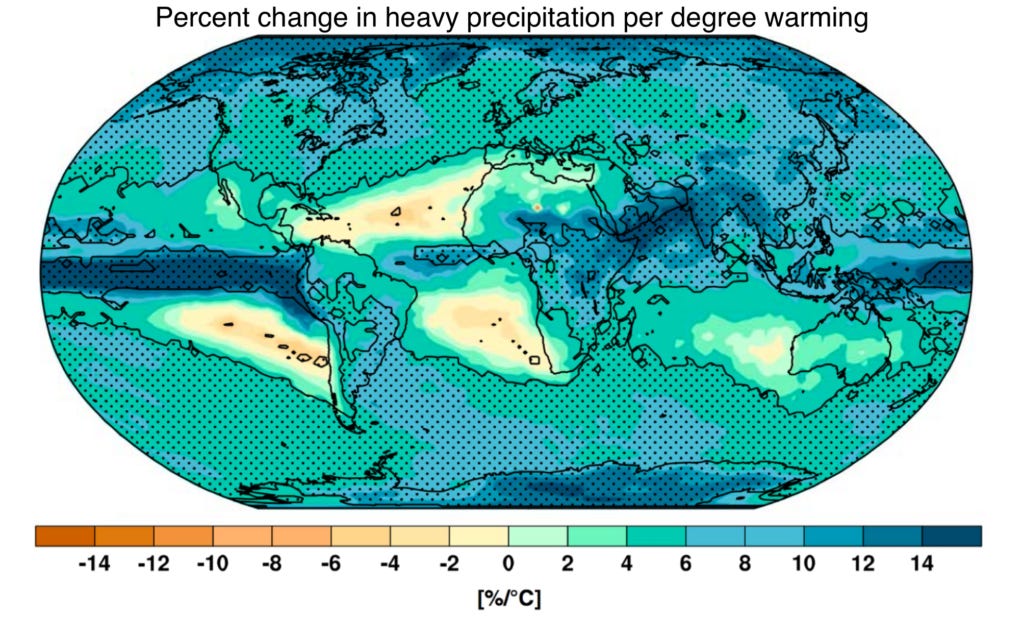
There is also evidence that this relationship between warming and rainfall is even stronger in hurricanes, which can result in “super-scaling” of the Clausius-Clapeyron relation that governs increases in atmospheric water vapor and temperature. As Liu et al 2019 note, “the percentage increase for inner-core tropical cyclone rainfall rates in our model is markedly larger than the Clausius-Clapeyron rate” and scales with storm intensity. They found that rainfall from tropical storms increases by 13% per degree C to 17% per degree C (e.g. an increase 17% to 22% at current warming levels of 1.3C above preindustrial).
You will not escape the climate crisis
Posted on 7 October 2024 by Guest Author
This is a re-post from the Climate Brink by Andrew Dessler
On Bluesky, it was pointed out that Asheville, NC was recently listed as a place to go to avoid the climate crisis.
Mother Nature sent a “letter to the editor” indicating that she didn’t agree:
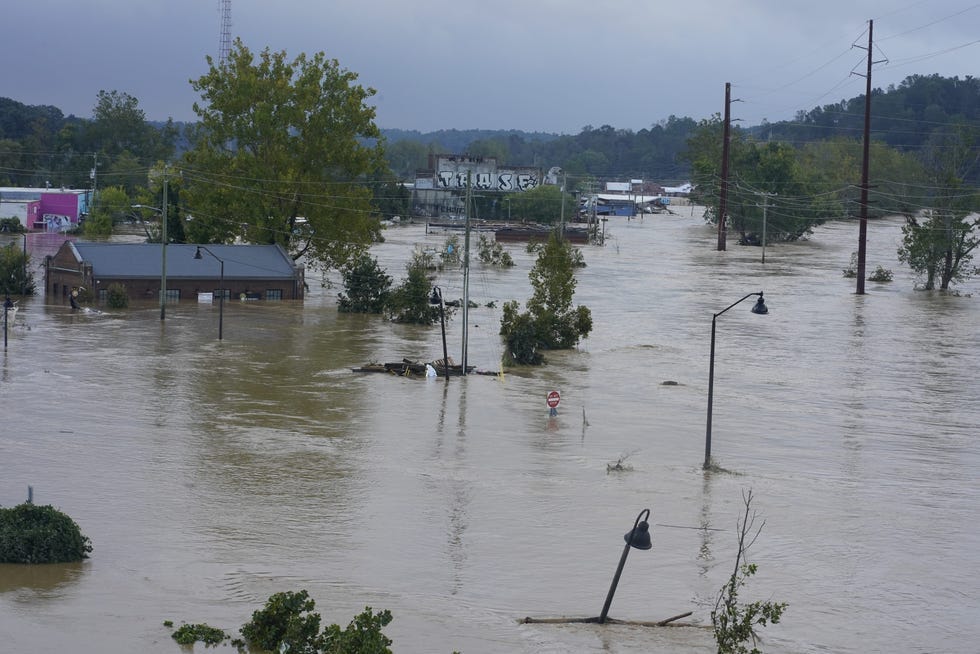
Helene’s climate link
While climate change does not cause hurricanes, we are certain it makes them more destructive. Humans have increased sea level, leading to more destructive storm surge, and a warmer atmosphere produces more rain.
Many people don’t understand how this will affect them. They think it’s a long-term problem where small impacts accumulate over decades, eventually leading to significant consequences far in the future.
In reality, though, these increases in storm surge and rainfall push our physical environment beyond thresholds that infrastructure was designed to handle.
As a result, the impacts of climate change are non-linear: they are zero until you cross the threshold and then, suddenly, you are wiped out. This leads to headlines like this:
2024 SkS Weekly Climate Change & Global Warming News Roundup #40
Posted on 6 October 2024 by BaerbelW, Doug Bostrom, John Hartz
Story of the week
We're all made of standard human fabric so it's nobody's particular fault but while "other" parts of the world have very recently lived (mostly) through enormous floods with huge consequences, only over the past week has the United States focused its immediate attention on hydrometeorological extremes— thanks to the arrival and massive hammer blow of Hurricane Helene and its titanic delivery of rainfall (see "psychological distance").
Our Story of the Week is statistically obvious by headcount in the list below. It's all about Hurricane Helene. A common theme in reportage from affected areas is the element of surprise in arrival of flooding on a previously unimagined and unexperienced scale. Affected residents of a swathe of states spanning from Florida to Virginia were depending on guidance from experts to prepare for this storm and despite fairly strident warnings it's safe to say that the advice they received didn't encompass the unfolding reality of the storm, particularly as it intruded into the continental interior and subsequently stalled as it died away into a tropical depression.
How could we be so surprised by something as hard to hide as 40 triilion gallons (1.514 liters) of water? Perhaps it's because we're using outmoded and inappropriate metrics when evaluating the threat posed by hurricanes. Our focus when it comes to hurricane preparation has traditionally been centered on wind and storm surge. These are certainly germane to coastal locations in terms of threat to life and overall destruction. Storm surge in particular is an urgent matter for people and infrastructure directly facing seas and oceans.
But are wind and storm surge the center of mass of potential hurricane disaster? With so much inland population potentially affected by hurricanes— and with the behavior of hurricanes now being significantly affected by global warming— how best can emergency commmunications serve the public? A hint lies in the fact that fresh water delivered by hurricanes typically kills more people than do wind or surge.
Storm surge fades as a factor not far from the coastline. Farther than a relatively few miles from shore and leaving surge behind, a hurricane's principal impact and threat transitions from crazy wind speed and invasive waves to something more generally familiar: rain. Only this isn't normal rain but instead precipitation from air absolutely stuffed with moisture thanks to its passage over warm ocean. The warmer the water, the higher the risk. Hurricane Helene was positivily juiced with moisture by passing over a Gulf of Mexico that like the rest of the world ocean is freakishly warm, and the storm carried that moisture just as far as it could— before shedding its unbearable load on Georgia, Tennessee, South Carolina and Virginia.
We clearly need to be thinking about a different perspective on hurricane risk and how to talk about it, and fortunately we have experts doing exactly that. We didn't cover it in this week's listing but the New York Times just ran an article laying out the current defects with how we convey hurricane threats, The Problem With the Hurricane Category Rating. In a nutshell, over half of US hurricane fatalities are due to deluges of fresh water, yet our thinking about these disasters is myopically focused on coastal contexts. We do as a technical matter know much better. For a comprehensive review of circumspect weather hazard communications (important in a non-stationary climate!), see Improving Societal Outcomes of Extreme Weather in a Changing Climate: An Integrated Perspective (pdf), Morss et al., Annual Review of Environment and Resources.
Stories we promoted this week, by publication date:
Before September 29
- Sorry, AI won’t “fix” climate change, Opinion, MIT Technology Review, James Temple. "OpenAI’s Sam Altman claims AI will deliver an 'Intelligence Age,' but tech breakthroughs alone can't solve global warming."
- As Florida Storms Worsen, Some in Tampa Bay Wonder: Is Living There Worth It?, US, New York Times, Isabelle Taft, Elisabeth Parker, Valerie Boey Ramsey & Patricia Mazzei. "Residents of the booming region are confronting a new reality: Even when storms make landfall far away, their impact is being felt."
- A Controversial Play — and What It Taught Me About the Psychology of Climate, TedTalks on Youtube, David Finnigan.































 Arguments
Arguments
























 (Illustration credit: Samantha Harrington)
(Illustration credit: Samantha Harrington)